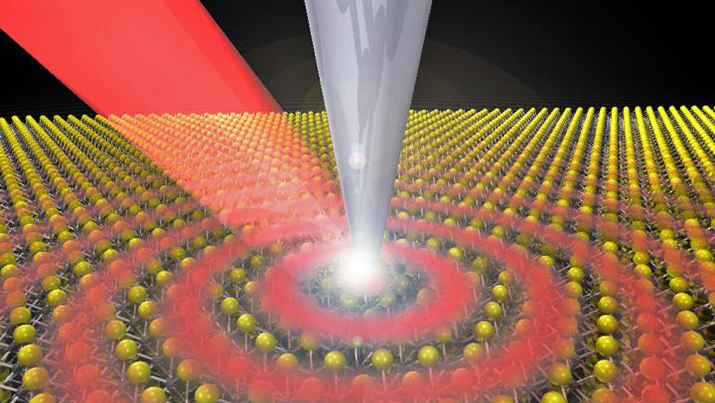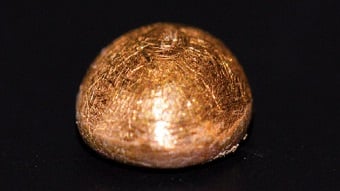Imaging Quasiparticles Could Lead to Quantum Breakthroughs
Tony Pallone | June 07, 2017 A laser (top left) shines on the sharp tip of a nano-imaging system aimed at a flat semiconductor. The red circles represent the waves associated with the quasiparticles. (Courtesy Zhe Fei/Iowa State University)For the first time, researchers have made real-space images of exciton-polaritons.
A laser (top left) shines on the sharp tip of a nano-imaging system aimed at a flat semiconductor. The red circles represent the waves associated with the quasiparticles. (Courtesy Zhe Fei/Iowa State University)For the first time, researchers have made real-space images of exciton-polaritons.
If you’re scratching your head, no worries. Exciton-polaritons are a combination of light and matter. Excitons can form when light is absorbed by a semiconductor; when they couple strongly with photons, they create exciton-polaritons. Exciton-polaritons are an example of a quasiparticle — a disturbance within a medium that behaves like a particle, possessing physical properties such as energy and momentum.
In a study led by Iowa State University’s Zhe Fei, exciton-polaritons were launched by shining a laser on the sharp tip of a nano-imaging system that was aimed at a thin flake of molybdenum diselenide (MoSe2), a layered semiconductor. The properties of the exciton-polaritons could be maninpulated by changing the thickness of the semiconductor.
According to Fei, who is also an associate of the U.S. Department of Energy’s Ames Laboratory, past research has recorded exciton-polaritons as resonance peaks or dips in optical spectra; most studies until recently have only observed them at extremely cold temperatures (around -450 degrees Fahrenheit). But Fei and his research group worked at room temperature with a scanning near-field optical microscope to take nano-optical images.
The researches were able to study propagation of the quasiparticles — significant for developing future applications. One day, they may be used to build nanophotonic circuits to replace electronic circuits for nanoscale energy or information transfer. Because of their large bandwidth, these nanophotonic circuits could be faster than current electrical circuits.
Up to one million times faster.
"We need to explore further the physics of exciton-polaritons and how these quasiparticles can be manipulated," Fei said.
That could lead to new devices such as polariton transistors, and subsequent breakthroughs in photonic and quantum technologies.




